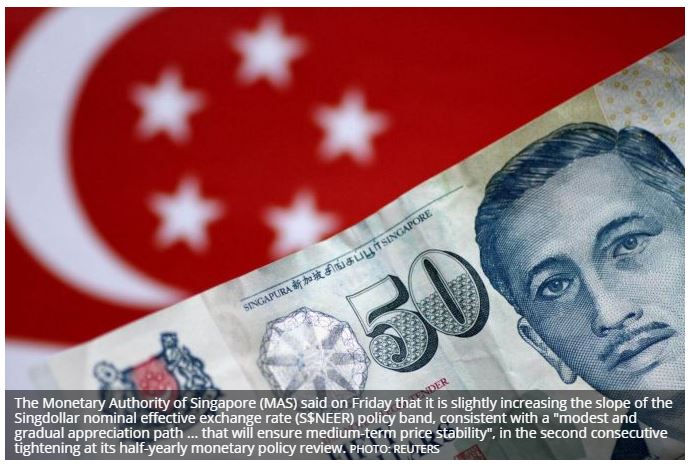Singapore: MAS to strengthen Singdollar at faster pace; expects economic growth to moderate in 2019
THE Monetary Authority of Singapore (MAS) is slightly increasing the pace of the Singapore dollar’s appreciation in keeping with a “modest and gradual appreciation path… that will ensure medium-term price stability”, marking the central bank’s second consecutive tightening at its half-yearly monetary policy review.
The width of the policy band and the level at which it is centred will be unchanged, the MAS said on Friday morning.
The MAS said the move comes as the Singapore economy “is likely to remain on its steady expansion path in the quarters ahead, keeping output slightly above potential”. It expects core inflation to experience “modest but continuing pressures” before levelling off at just below 2 per cent over the medium term.
The central bank expects 2018 economic growth to land within the upper half of the official forecast range of 2.5 to 3.5 per cent, and to moderate slightly in 2019. Core inflation is expected to average 1.5 to 2.5 per cent in 2019, slightly higher on the high side than the 1.5 to 2 per cent indication for 2018. Headline inflation is projected to be about 1 to 2 per cent next year, up from about 0.5 per cent in 2018.
“A small, positive output gap is expected to persist into 2019, imparting modest inflationary pressures,” the MAS said in its October monetary policy statement.
It also acknowledged the risk that trade wars could pose in the year ahead, saying: “Global growth has been relatively resilient thus far. In 2019, trade frictions between some major economies and the uncertainty they pose could weigh more discernibly on global economic activity.”
“Barring a significant setback in global growth, the Singapore economy should expand at a pace close to potential in 2019,” it added.
On Friday, the Ministry of Trade and Industry released advanced estimates showing that the Singapore economy grew 2.6 per cent year on year in the third quarter of 2018, moderating from 4.1 per cent growth in the preceding quarter.
The MAS manages the exchange rate against a trade-weighted basket of currencies of major trade partners. The Singdollar is allowed to float within an undisclosed policy band called the Singapore dollar nominal effective exchange rate (S$NEER) that can be adjusted when monetary policy is reviewed at half-yearly meetings in April and October.
In its April policy statement, the MAS moved out of the neutral stance it had held since April 2016, with the first tightening in six years.
Prior to Friday’s announcement, economists had been split on whether the MAS would tighten policy again in October, with inflation in the upper half of the official forecast range but global uncertainties growing. The market, however, seemed to have been expecting further tightening, with the S$NEER strengthening towards its upper bound.
Apart from brief periods of decline, the S$NEER has appreciated in the upper half of the policy band since the April statement, partly reflecting sharper depreciations in a number of regional currencies against the US dollar, relative to the Singdollar.
Economists noted that October’s statement seemed relatively hawkish, but were divided on whether that signals further tightening in 2019.
ANZ Research head of Asia research Khoon Goh noted that though trade frictions were mentioned in the October statement, they “were generally downplayed”. With the MAS expecting only slight growth moderation and continuing inflation pressures in 2019, this suggests that “the MAS is not yet done with policy normalisation, and a further increase in the S$NEER slope is likely if the economy evolves as the MAS expects”, he added. ANZ’s baseline view is for another tightening in April 2019.
OCBC head of treasury research and strategy Selena Ling saw “no explicit dovish overtones” in the October statement, adding that “the inflation rhetoric has evolved and hardened in our view”. The April statement had expected imported inflation to “rise mildly” and domestic inflation to “rise gradually”; in contrast, October’s statement said imported inflation “is likely to increase” and noted that growth in unit labour cost for services has picked up.
However, Ms Ling’s view is that “it remains doubtful if there will be any further tightening impetus in 2019”, with the S$NEER gradient likely to be more modest compared to its slope before the global financial crisis, given today’s global growth environment.
In a note on Friday morning, UOB Global Economics and Markets Research observed that amid the overnight US dollar correction and prior to the release of MAS’s decision, the USD/SGD spot rate had already “pulled back noticeably” from Thursday’s intraday high of 1.3830 to about 1.3760.
Following the announcement, the Singdollar strengthened against the USD, trading at S$1.3736 to the US dollar at 10.45am, from its close of S$1.3764 on Thursday.
DBS FX strategist Philip Wee and rates strategist Eugene Leow expect the upside to the Singdollar to be limited around 1.3730 against the USD on Friday morning, noting that the S$SNEER “is currently only 0.2 per cent below the ceiling of the band”. Their view remains for the greenback to keep appreciating in the final quarter of the year, with the USD/SGD rate eventually rising above 1.40.
Source: https://www.businesstimes.com.sg/government-economy/mas-to-strengthen-singdollar-at-faster-pace-expects-economic-growth-to-moderate


 Thailand
Thailand




